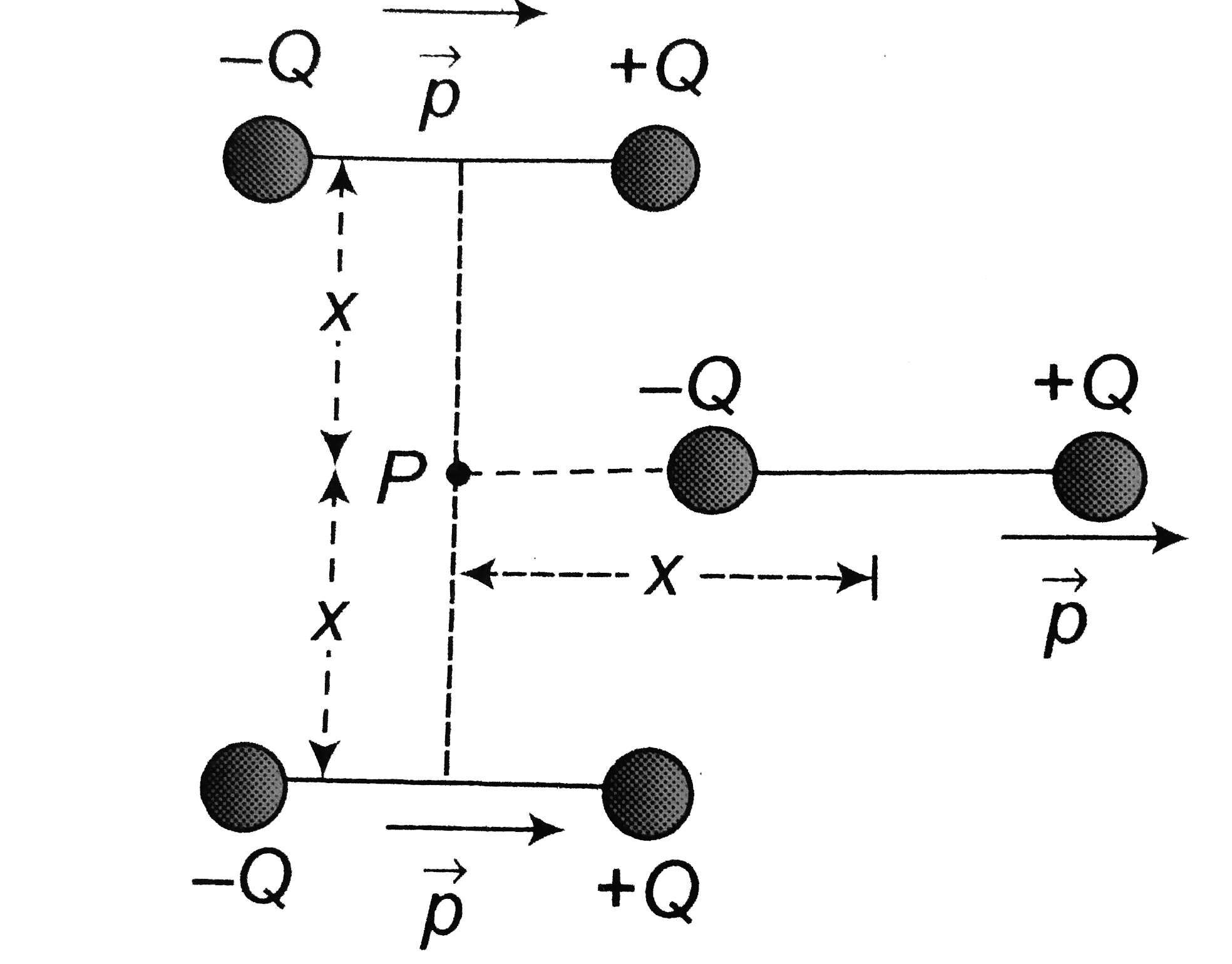The magnitude of electric field intensity at point B(2,0,0) due to dipole of dipole moment, →p=ˆi+√3ˆj kept at origin is (assume that the point B is at large distance from the dipole and k=14πε0)
√13K8
√13K4
√7K8
√7K4
The correct Answer is:C
To find the magnitude of the electric field intensity at point B(2,0,0) due to a dipole moment →p=^i+√3^j located at the origin, we can follow these steps:
Step 1: Identify the dipole moment and its components
The dipole moment is given as:
→p=^i+√3^j
This can be expressed in terms of its components:
- px=1 (coefficient of ^i)
- py=√3 (coefficient of ^j)
Step 2: Calculate the magnitude of the dipole moment p
The magnitude of the dipole moment p is given by:
p=√p2x+p2y=√12+(√3)2=√1+3=√4=2
Step 3: Determine the position vector from the dipole to point B
The position vector →r from the dipole (at the origin) to point B(2,0,0) is:
→r=2^i+0^j+0^k
The distance R from the dipole to point B is:
R=|→r|=2
Step 4: Calculate the angle θ between the dipole moment and the position vector
To find the angle θ between the dipole moment →p and the position vector →r, we can use the dot product:
cosθ=→p⋅→r|→p||→r|
Calculating the dot product:
→p⋅→r=(1)(2)+(√3)(0)=2
The magnitudes are:
- |→p|=2
- |→r|=2
Thus,
cosθ=22⋅2=12
This gives us:
θ=60∘
Step 5: Use the formula for the electric field due to a dipole
The formula for the electric field E at a point making an angle θ with the dipole moment is:
E=kpR3(1+3cos2θ)
Substituting the known values:
- k=14πϵ0
- p=2
- R=2
- cos60∘=12
Calculating E:
E=k⋅223(1+3(12)2)
E=k⋅28(1+3⋅14)
E=k⋅28(1+34)=k⋅28⋅74
E=k⋅2⋅732=7k16
Step 6: Final expression for the electric field
Thus, the magnitude of the electric field intensity at point B(2,0,0) is:
E=7k16
The dipole moment is given as:
→p=^i+√3^j
This can be expressed in terms of its components:
- px=1 (coefficient of ^i)
- py=√3 (coefficient of ^j)
The magnitude of the dipole moment p is given by:
p=√p2x+p2y=√12+(√3)2=√1+3=√4=2
The position vector →r from the dipole (at the origin) to point B(2,0,0) is:
→r=2^i+0^j+0^k
The distance R from the dipole to point B is:
R=|→r|=2
To find the angle θ between the dipole moment →p and the position vector →r, we can use the dot product:
cosθ=→p⋅→r|→p||→r|
Calculating the dot product:
→p⋅→r=(1)(2)+(√3)(0)=2
The magnitudes are:
- |→p|=2
- |→r|=2
cosθ=22⋅2=12
This gives us:
θ=60∘
The formula for the electric field E at a point making an angle θ with the dipole moment is:
E=kpR3(1+3cos2θ)
Substituting the known values:
- k=14πϵ0
- p=2
- R=2
- cos60∘=12
E=k⋅223(1+3(12)2)
E=k⋅28(1+3⋅14)
E=k⋅28(1+34)=k⋅28⋅74
E=k⋅2⋅732=7k16
Thus, the magnitude of the electric field intensity at point B(2,0,0) is:
E=7k16
Similar Questions
The magnitude of electric field intensity at point B(x,0,0) due to a dipole of dipole moment , →P−P0(ˆi+√3ˆj) kept at origin is √n(kp0r3), find n (assume that the point is at large distance form the diople , k=14π∈0 .
View SolutionThe electric field intensity →E , , due to an electric dipole of dipole moment →p , at a point on the equatorial line is :
View Solution
Knowledge Check
Electric field intensity (E) due to an electric dipole varies with distance (r ) from the point of the center of dipole as :
A1rand1r2B1r2and1rC1r3and1r3D1r3and1r2
An electric dipole of moment rp=(ˆi+2ˆj)×10−28Cm is at origin. The electric field at point ( 2,4) due to the dipole is parallelto
View SolutionAn electric dipole of moment rp=(ˆi+2ˆj)×10−28Cm is at origin. The electric field at point ( 2,4) due to the dipole is parallelto
View SolutionA dipole of dipole moment P is kept at the centre of a ring of radius R and charge Q. If the dipole lies along the axis of the ring. Electric force on the ring due to the dipole is : (K=14πε0)
View SolutionElectric potential due to a dipole at a position →r from its centre is: where (K=14πε0
View Solution
Two point electric dipoles with dipole moment P1 and P2 are separated by a distance r with their dipole axes mutually perpendicular as shown. The force of interaction between the dipoles is (where k=14πε0)
View SolutionWhat is the angle between the directions of electric field due to an electric dipole and its dipole moment at any :
(i) Axial p oint . (ii) Equatorial point .
View SolutionThree identical dipoles are arranged as shown below. What will be the net electric field at P(k=14πε0)

View Solution
